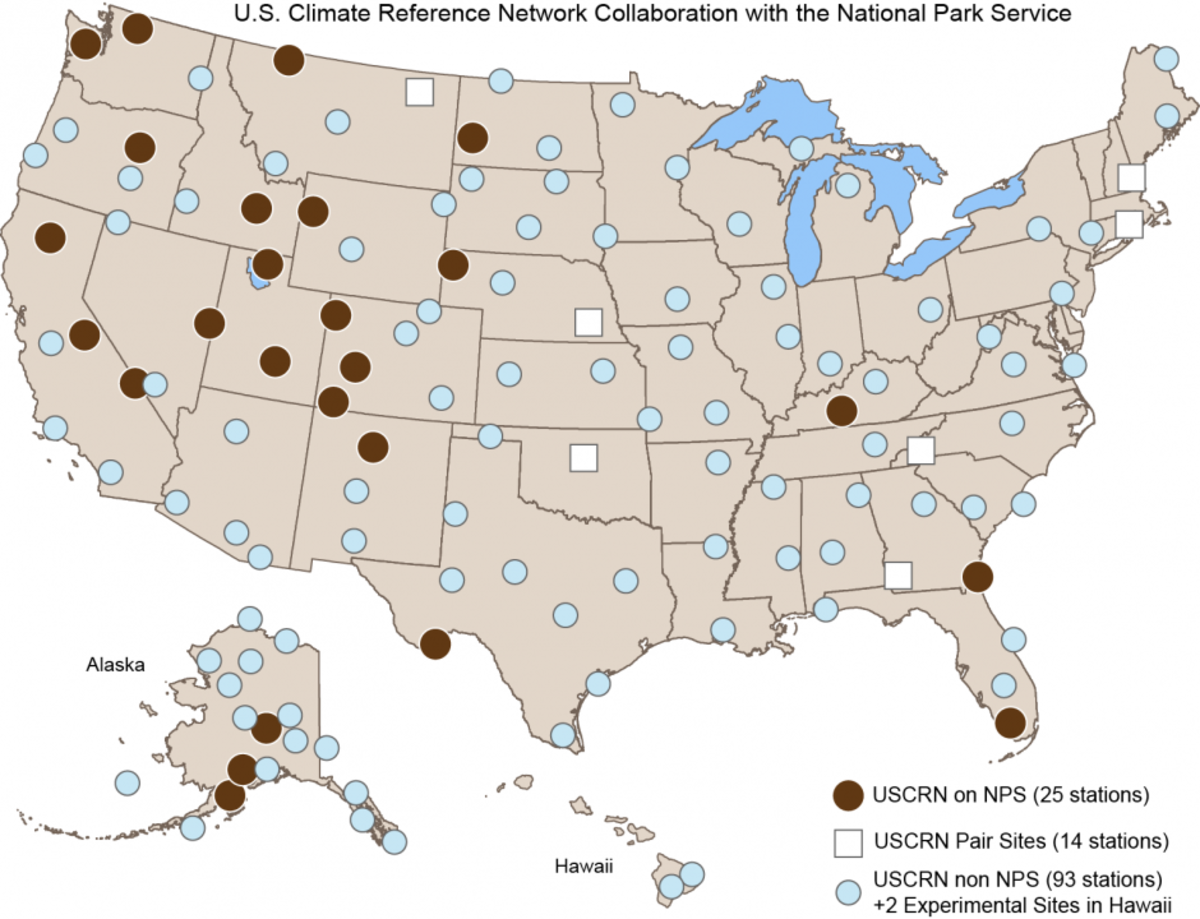
In August 1916, President Woodrow Wilson signed the act creating the National Park Service (NPS) to safeguard and steward the young but growing National Park System. The NPS mission is to preserve “unimpaired the natural and cultural resources and values of the National Park System for the enjoyment, education, and inspiration of this and future generations.” These preserved and pristine locations provided the perfect opportunity for collaboration with the U.S. Climate Reference Network (USCRN) program, which aims to monitor climate in stable, open landscapes.

Since 2002, NCEI has managed and operated the USCRN in partnership with NOAA’s Atmospheric Turbulence and Diffusion Division. The USCRN’s mission is to monitor the climate across the United States in pristine locations for the next 50 years and provide user-driven information products based on these measurements. It consists of a systematic and sustained network of stations with sites across the conterminous United States, Alaska, and Hawaii. These stations use high-quality instruments to measure temperature, precipitation, soil conditions, and more.
The USCRN program has collaborated with the NPS since 2003, placing climate-observing stations in national park units around the country. Currently, 25 USCRN stations are located in NPS units. In commemoration of the NPS centennial, the USCRN program will release a series of reports describing the stations located in NPS sites across eight regions of the United States. These reports will also describe the environments in which the stations are located, recount interesting events, and provide a preliminary look at the climatology of these locations. Check out the table below to see all of the USCRN stations located in national parks.
| Installation Date | Name of Station | National Park Service Site | Region |
|---|---|---|---|
| Mar 25, 2003 | Redding 12 WNW, CA | Whiskeytown National Recreation Area | Northwest |
| Apr 3, 2003 | Darrington 21 NNE, WA | North Cascades National Park | Northwest |
| Jul 10, 2003 | Arco 17 SW, ID | Craters of the Moon National Monument | Northern Rockies |
| Aug 27, 2003 | Harrison 20 SSE, NE | Agate Fossil Beds National Monument | Great Plains |
| Sep 25, 2003 | St. Mary 1, MT | Glacier National Park | Northern Rockies |
| Mar 16, 2004 | John Day 35 WNW, OR | John Day Fossil Beds National Monument | Northwest |
| May 5, 2004 | Stovepipe Wells 1 SW, CA | Death Valley National Park | Southwest |
| May 9, 2004 | Baker 5 W, NV | Great Basin National Park | Southwest |
| May 19, 2004 | Bowling Green 21 NNE, KY | Mammoth Cave National Park | East |
| Jul 1, 2004 | Moose 1 NNE, WY | Grand Teton National Park | Northern Rockies |
| Jul 21, 2004 | Dinosaur 2 E, CO | Dinosaur National Monument | Central Rockies |
| Jul 25, 2004 | Montrose 11 ENE, CO | Black Canyon of the Gunnison National Park | Southern Rockies |
| Jul 31, 2004 | Los Alamos 13 W, NM | Valles Caldera National Preserve | Southern Rockies |
| Sep 18, 2004 | Medora 7 E, ND | Theodore Roosevelt National Park | Great Plains |
| Dec 16, 2004 | Brunswick 23 S, GA | Cumberland Island National Seashore | East |
| Nov 2, 2005 | Cortez 8 SE, CO | Mesa Verde National Park | Southern Rockies |
| Sep 9, 2006 | Quinault 4 NE, WA | Olympic National Park | Northwest |
| Feb 10, 2007 | Everglades City 5 NE, FL | Big Cypress National Preserve | East |
| Feb 25, 2007 | Panther Junction 2 N, TX | Big Bend National Park | Great Plains |
| Aug 19, 2007 | Brigham City 28 WNW, UT | Golden Spike National Historic Site | Central Rockies |
| Sep 29, 2007 | Yosemite Village 12 W, CA | Yosemite National Park | Southwest |
| Oct 4, 2007 | Torrey 7 E, UT | Capitol Reef National Park | Central Rockies |
| Sep 25, 2009 | Port Alsworth 1 SW, AK | Lake Clark National Park | Alaska |
| Aug 17, 2012 | King Salmon 42 SE, AK | Katmai National Park | Alaska |
| Aug 20, 2015 | Denali 27 N, AK | Denali National Park | Alaska |



